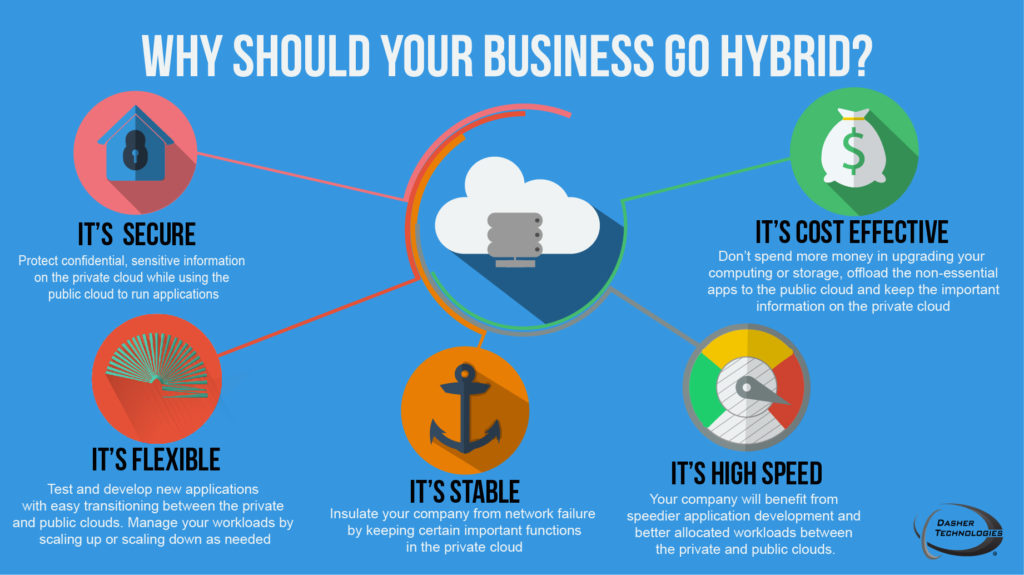by Chris Saso, CTO
Why Should Your Business Go Hybrid?
Ideas Are the New “Revolution”
The Industrial Revolution changed the way we manufactured products for consumption and raised the standard of living for societies across the globe. Today, the Idea Revolution is enabling a rapid creation of products and services that can be brought to market by anyone with a great idea. Ideas pop into people’s heads every day and now, with the dramatic increase in mobile devices, rapid communications and a connected world via the internet, it is possible to create a business with an idea and a few laptops.
Why Hybrid IT is the Enabling Force of the Idea Revolution
The entrepreneur of today takes an idea, hires developers anywhere in the world and launches their company in the public cloud. As they look to raise money, they are able to demonstrate their idea to the VC’s with far less personal capital outlay than ever before. As the company and idea grow, the need for hybrid IT becomes clear. When moving from the prototyping phase to actual product release and ongoing development, some workloads are better suited to stay in the public cloud and others are better suited to run in a private cloud environment either in the company’s shiny new headquarters or in a co-location facility where “smart hands” folks can take care of day-to-day physical hardware issues that arise with IT infrastructure.
What is Hybrid IT?
I define Hybrid IT as the ebb and flow of workloads between public and private clouds that enable businesses to deliver on their ideas. Below is an overview of the key components of a hybrid IT strategy that will build a solid IT foundation ensuring the success of an organization.

Security
Because employees are mobile, security must be mobile as well and securing your IP within your public and private cloud is a must. One of my team members just returned from BlackHat where he soaked up the latest information about companies’ strategies to combat the bad guys. One theme he heard over and over from attendees was that a comprehensive security strategy is made up of people, process and technology and that technology is probably the least important aspect of the three. When it comes to technology, the folks he talked to suggested that monitoring is one of the most critical aspects of a security strategy. No matter where your data resides, be it in the public or private cloud, you need to be able to view what is going on with your data and where it is moving. Once you have visibility you can address technology solutions to address security vulnerabilities. The other key point he picked up was that unfortunately, it is a combination of many technology solutions that offer the best chance to combat the bad guys, there is no one simple product that can keep a company’s ideas safe.
Flexibility & High Speed
Companies of all sizes are striving to constantly improve time to market for their solutions. For startups, the public cloud is a great choice to enable rapid and low barrier-to-entry development. For large corporations, the public cloud can be a great way to behave like a nimble startup and prototype new solutions. As the solutions mature, a hybrid IT infrastructure starts to make sense because it gives flexibility and scale for testing and development, and allows you to run mission critical and/or client data based IP in the private cloud or public cloud, whichever is a better fit. The increase in mature orchestration technologies is beginning to make the promise of workload flexibility a reality. Orchestration solutions enable rapid movement of workloads between a well designed private and public cloud hybrid IT infrastructure.
Stability
Business continuity and disaster recovery are important for all companies. A hybrid cloud solution by definition is at least two locations, one in your own data center or colo, and one in the public cloud. You can use this inherent dual location strategy to create a BC/DR strategy by enabling the ability to run your workloads in either public or private clouds. Whether there is a natural disaster, a network outage or a human error that causes downtime at one location, a well designed hybrid IT solution will protect against a single site causing a business critical outage.
Cost Effective
For startups and new projects in large corporations the ability to “acquire” IT resources in the public cloud at pennies per compute and storage is a very cost effective way to learn if a new “idea” can lead to a viable new product or service. As companies mature and the use of public cloud matures, it can sometimes become clear that running a large scale application 24×7 is more cost effective in a private cloud. Performing TCO and ROI comparisons of public and private cloud solutions involving servers, storage, security and networking is something that the new breed of IT professional need to be proficient at. When the CFO of a company goes to the CIO to asks why their public cloud IT bill is “so high,” the CIO of today needs tools to show either why the company should continue to run that particular workload in the public cloud or why it should be moved to a private cloud environment. Every workload is different and therefore keeping a watchful eye on how the application runs, how it is structured, how much network bandwidth it uses, how much storage it uses, how much compute it uses are all critical factors to deciding where the workload should live so it runs in the most cost effective way for the company and keeps the cost of running your “idea” to a minimum.
Additional Articles:
- https://www.hpe.com/us/en/solutions/transform-hybrid.html?pp=false&jumpid=ps_kt57f3vsmg_aid-510315615&gclid=CPuHgsr0uNUCFYkOfwodM0gMlA&gclsrc=ds
- https://hbr.org/2016/03/hybrid-business-models-look-ugly-but-they-work
- https://www.informationweek.com/cloud/infrastructure-as-a-service/hybrid-cloud-7-ways-its-the-best-of-both-worlds/d/d-id/1322559?image_number=9
- https://www.ibm.com/midmarket/us/en/forwardview/article_Cloud1_1204.html
- https://www.forbes.com/sites/moorinsights/2016/10/04/the-hybrid-cloud-dilemma/#45f4397f45be

